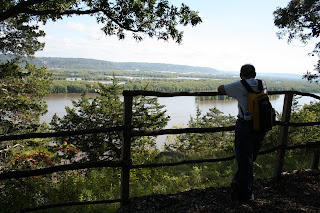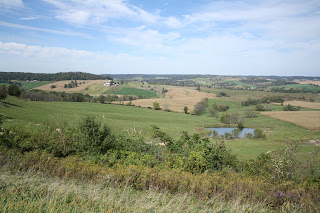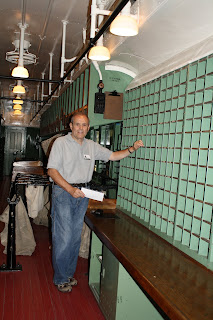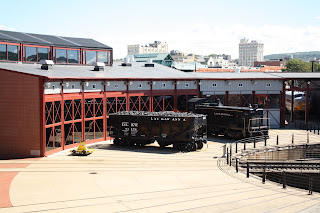
Rain, rain, enough! But we understand that Pennsylvania needs it as badly as New England this year. Unfortunately, Little Red is not as waterproof as a car should be. After 15 years, the door moldings leak, and I forgot that had been a problem since rain has been so rare this past summer. We can even hear the drip as water drops fall on the cooler in the back just behind my head. But George Washington had it a lot worse when it poured all during the French attack on Fort Necessity. A Kleenex box solved our problem temporarily, and the weather should clear tomorrow. In the meantime, our hikes have been cut short by downpours off and on all day. Washington, on the other hand, faced the annihilation of half of his 400 men.
The only tourists at Fort Necessity National Battlefield, we watched the 25-minute educational film, amazed at the history we had missed along the way. I never knew George Washington made such serious tactical mistakes as a 22-year old. It started the French and Indian War when he accidentally signed a water-smudged surrender that stated he had murdered a French officer.
Our second stop, Christian W. Klay Winery in Chalk Hill, Pennsylvania, offered a refuge from the 11:00 a.m. drenching and lots of quality samples for tasting.
Washington's Tavern was closed, but we dashed around the old Georgian mansion in between raindrops. Luckily, our wind breakers only absorbed some of the water.
Braddock's grave was equally as drenched, but we ran out for a quick look at the final resting place of the British general who triggered Indian hatred of the British by addressing the American Indians as savages. Washington buried him in the middle of the road he was clearing for westward travel so the Indians couldn't desecrate his body.
Friendship Hill National Historic Site, the frontier home of Albert Gallatin, secretary of the treasury for 13 years in the late 1700's and early 1800's, would fascinate kids as well as adults. With free-standing staircases of 21 steps each and four or five additions between 1728 and 1902, the house is a fascinating assemblage of unusual architecture and significant U.S. historical influences. Gallatin wanted to balance the budget and reduce the national debt. He advocated for public education and argued against slavery. We need him today! The private tour was a treat, and our guide, superb.
Arriving in Morgantown, West Virginia, Andy checked in at the hotel desk wearing his Virginia Tech tee-shirt.
"I don't think it's a good idea to wear that around here," she said.
"I guess you are right," he answered, "but this is my $85,000 shirt, so I maintain a certain level of allegiance."
Los Mariachis won out over Chick Fil A for dinner. Yum! No arguments with that choice!
 At the Missouri River Overlook on I-90, a tepee made of concrete bars marks the 1804 and 1806 Missouri River campsite of Lewis and Clark. Here they collected specimens of pronghorn and prairie dogs; it was a welcome oasis where they stayed two full days both going and coming.
At the Missouri River Overlook on I-90, a tepee made of concrete bars marks the 1804 and 1806 Missouri River campsite of Lewis and Clark. Here they collected specimens of pronghorn and prairie dogs; it was a welcome oasis where they stayed two full days both going and coming.









 We crossed the Mighty Mississippi late this afternoon.
We crossed the Mighty Mississippi late this afternoon.















 "I feel so dumb!" I said to Andy at the end of our travel day.
"I feel so dumb!" I said to Andy at the end of our travel day.








 Andy, already in job retraining, files the mail for the railroad. He wasn't qualified enough to shovel coal or polish engines.
Andy, already in job retraining, files the mail for the railroad. He wasn't qualified enough to shovel coal or polish engines.
